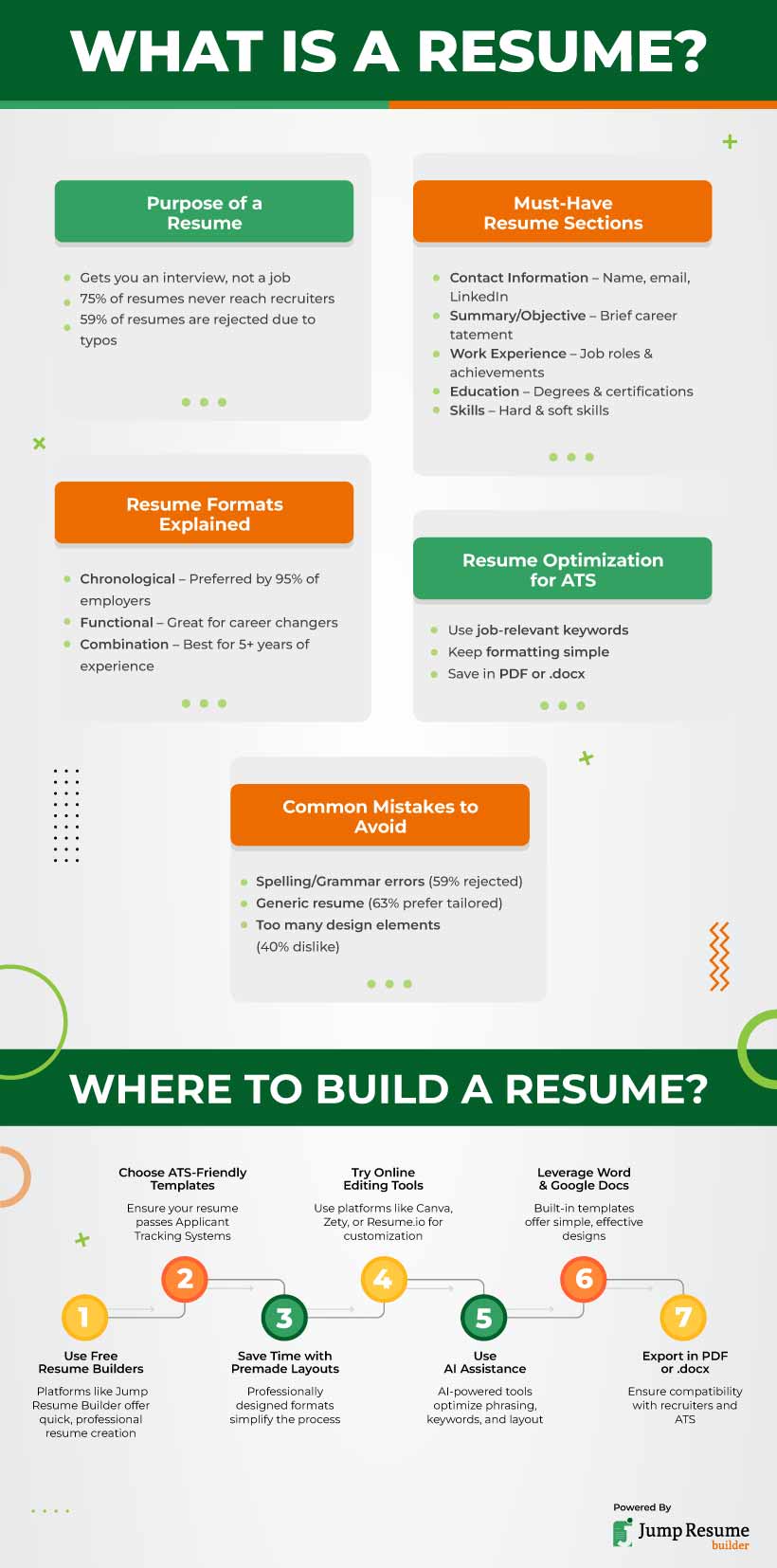In today’s competitive job market, a strong resume helps job seekers stand out.
Many believe a resume gets them a job, but its main purpose is to get an interview. On average, each corporate job gets about 250 resumes, but only 2% of applicants get interviews. Also, 75% of resumes never reach a hiring manager because they do not pass through Applicant Tracking Systems (ATS).
Even more, 59% of recruiters reject resumes with grammar or spelling mistakes.
That is why it is important to understand how to write a good resume. In this guide, we will explain what a resume is, why it matters, and how to create one using free online resume-building tools in the USA.
What is a Resume? Understanding Its Purpose
A resume is a short document, usually one to two pages long. It lists your work experience, skills, education, and achievements.
It helps employers learn about your qualifications quickly. A resume is like an advertisement for yourself, showcasing why you are a good fit for a job. However, despite its extensive use, some argue that resumes vs. application forms: why the stubborn reliance on resumes? is a valid discussion, as many hiring processes still depend heavily on resumes rather than structured application forms.
1.1 Understanding Resumes – A Clear and Concise Definition
A resume is a short document, usually one to two pages long.
A resume is a formal document that gives a short summary of your work experience, skills, education, and achievements. It is an important part of applying for a job. A resume helps employers quickly see if you are a good fit for the position.
In many ways, a resume is like an advertisement for yourself. It shows your strengths, qualifications, and past work in a way that grabs the attention of hiring managers. A good resume should be clear, easy to read, and focused on the job you want.
Employers often get many applications for one job. A strong resume can help you stand out from other candidates. It should clearly show how your experience matches the job and why you would be a great choice for the company.
1.2 Purpose of a Resume
Some people think a resume helps them get a job. However, this is not true. A resume’s main goal is to get you an interview. It does this by:
- Giving employers a quick summary of your skills and experience.
- Helping them choose candidates who match the job requirements.
- Making a strong first impression before the interview.
- A well-written resume increases your chances of being called for an interview.
How Resumes Are Used by Job Applicants and Employers
2.1 How Job Applicants Use Resumes
A resume helps job seekers in many ways.
First, they send resumes to employers to start the job application process. This gives employers a quick look at their qualifications. Next, applicants introduce themselves through resumes, providing a formal summary of their work and skills.
Resumes also showcase achievements by listing important successes.
Lastly, they serve as a career record, helping applicants track their job history and progress over time.
2.2 How Employers Use Resumes
Employers use resumes to find the best candidates.
First, they analyze hiring trends by studying resumes from many job seekers. This helps them understand what skills are in demand. With the shift in employment strategies, companies are increasingly focusing on skills or degrees. The Rise of Skill-Based Hiring for AI and Green Jobs rather than just educational qualifications. Second, they screen applicants using ATS software, which filters resumes based on important keywords.
Next, they review career growth to see how a person has advanced in their field.
Finally, they check personal branding and online presence by looking at LinkedIn profiles and portfolios.
Looking for resume templates? We offer professionally designed options.
Key Components of a Resume (Structuring it Right)
A well-structured resume highlights your qualifications and makes a strong first impression. Here are the key sections every resume should include:
3.1 Essential Resume Sections
A well-structured resume highlights your qualifications and makes a strong first impression.
Here are the key sections every resume should include:
- Contact Information – Name, phone, email, LinkedIn.
- Resume Summary or Objective – A brief, compelling career statement.
- Work Experience – Job roles, responsibilities, and key achievements.
- Education – Degrees, certifications, and training.
- Skills – A mix of hard skills (technical expertise) and soft skills (communication, leadership, teamwork, etc.).
- Certifications & Achievements – Industry awards and recognitions.
3.2 Three Types of Resume Formats
1. Chronological Resume (Most Common Format)
Best for: Job seekers with steady work history.
Structure: Lists jobs in reverse chronological order.
Why It Works: Easy for recruiters to scan and preferred by 95% of employers.
2. Functional Resume (Skills-Based Format)
Best for: Career changers, new graduates, or people with employment gaps.
Structure: Focuses on skills instead of job experience.
Why It Works: Highlights transferable skills for new career paths.
3. Combination Resume (Hybrid Format)
Best for: Professionals with 5+ years of experience.
Structure: Blends both skills and work history.
Why It Works: Shows expertise while emphasizing achievements.

Applicant Tracking Systems (ATS) & Resume Optimization
4.1 What is an ATS?
An Applicant Tracking System (ATS) is a computer program that helps companies hire new employees.
It makes the hiring process easier by keeping all job applications in one place. When a company posts a job online, the ATS collects all the applications. Then, it organizes the information so employers can quickly find the best candidates.
Moreover, this system looks for important words in resumes to see if a person is a good match for the job.
In addition, an ATS can help with scheduling interviews and sending emails to applicants. Many companies use this system because it saves time and makes hiring faster. If you are applying for a job, you should make sure your resume is clear and includes the right words.
This will help the ATS find your application and increase your chances of getting an interview.
4.2 How to Make Your Resume ATS-Friendly
To increase your chances of getting noticed by Applicant Tracking Systems (ATS), follow these key strategies:
- Use job-relevant keywords from the job description.
- Keep formatting simple – Avoid excessive graphics, colors, or columns.
- Save in PDF or .docx format for compatibility.
4.3 Common Resume Mistakes That Get You Rejected
- Spelling and Grammar Errors – 59% of recruiters reject resumes with typos.
- Generic Resumes – 63% of recruiters prefer resumes tailored to the job.
- Unprofessional Email Addresses – Avoid informal addresses (e.g., crazyguy123@email.com).
- Too Many Design Elements – 40% of recruiters dislike resumes with excessive formatting.
Where to Create a Resume for Free?
Benefits of Using Resume Builders
Creating a resume from scratch can take a lot of time. However, Jump Resume Builder make the process much easier. They offer well-designed templates, so you can quickly create a professional resume. In addition, these tools help ensure your resume is formatted correctly for job applications.
- Saves Time – Pre-made templates help you complete your resume faster.
- ATS-Friendly – Many tools format resume to pass Applicant Tracking Systems (ATS), which scan for keywords.
- Customizable Designs – You can choose a layout that matches your industry and personal style.
Final Resume Checklist Before Applying for a Job
A well-crafted resume increases your chances of securing a job.
First, proofread carefully to eliminate grammar mistakes. Next, ensure it is ATS-friendly by using simple fonts, relevant keywords, and clean formatting. Finally, maintain consistency between your resume and LinkedIn profile to strengthen your professional branding.
- Proofread for errors – Grammar mistakes lower your chances.
- Ensure ATS compatibility – Simple fonts, keywords, and clean formatting.
- Tailor resume for each job – Align with job descriptions.
- Match LinkedIn profile – Keep professional branding consistent.
Conclusion: Start Building Your Resume Today
A strong resume helps you get an interview. However, employers review resumes to choose the best candidates and assess career progress. Therefore, it is important to create a resume that stands out.
Key Takeaways:
- A resume does not get you the job. Instead, it helps you get an interview.
- In fact, 75% of resumes never reach a recruiter.
- To improve your chances, use ATS-friendly formatting.
- Additionally, try free online resume builders for quick and professional templates.
If you want a resume that stands out, use our Free Resume Builder and take the next step toward your dream job.




